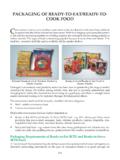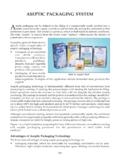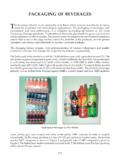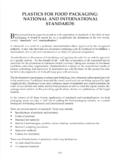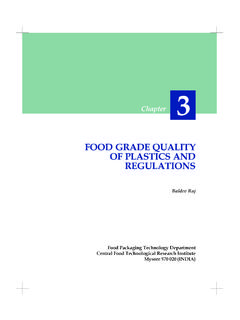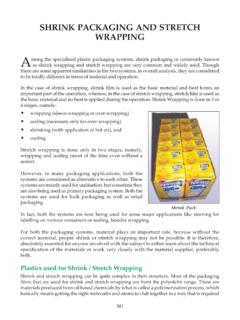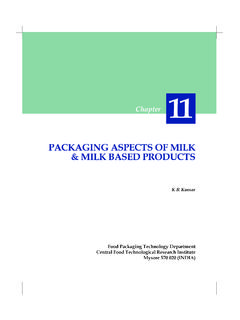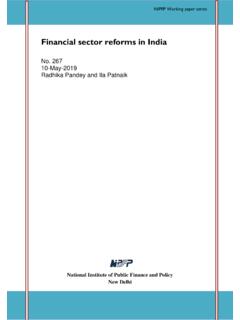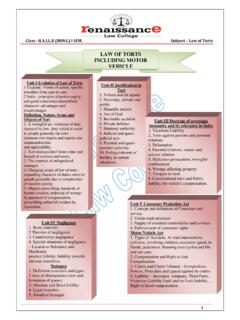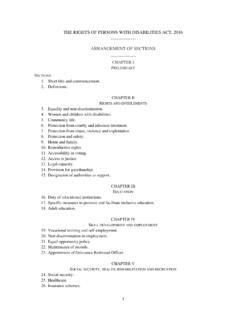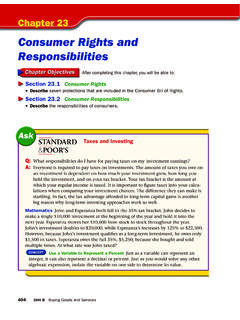Transcription of PACKAGING LAWS AND REGULATIONS - ICPE
1 415 PACKAGING laws AND REGULATIONSThe link between food PACKAGING and consumer protection is of high significance. A packageis a vehicle of safety and achieves the objective of delivering safe, wholesome, nutritiousfood to the consumer . To safeguard the interests of the consumer and the society at large, PACKAGING laws and REGULATIONS have been introduced by the Indian Regulatory System falls under the category of compulsory legislations formulatedby the various ministries and voluntary standards framed by various organisations to serve thecountry. The National Regulatory System is shown in Table PACKAGING laws and REGULATIONS for food products are mainly covered under: The Standards of Weights and Measures Act, 1976 and the Standards of Weights andMeasures (Packaged Commodities) Rules, 1977 (SWMA).
2 The Prevention of Food Adulteration Act, 1954 and the Prevention of Food AdulterationRules, 1955 and its first ammendment, 2003 (PFA). The Fruit Products Order, 1955 (FPO) The Meat Food Products Order, 1973 (MFPO) The Edible Oil PACKAGING Order, 1998 The Agmark RulesThe Standards of Weights & Measures Act (SWMA)Till about 25 years ago or so, the consumer was not sure that he was getting for his money,the right weight or volume of the packaged products. Things were pretty chaotic withdifferent states having their own system of weights and measures. Adding to the confusionwas the common practice of putting the same quantity of products in packs of differentsizes, some containers being half-filled, and, as if this was not enough, quantities of contentson the packs were not stated in terms of units of weight or measure but declared as familypack , economy size , full size and so on.
3 This unhappy state of affairs prevailed till1976 when the Government of India, brought forward a wise and enlightened pieceof legislation in the form of The Standards of Weights and Measures Act, 1976(SWMA).Some of the important aspects of SWMA are highlighted Units (section 4)Chapter I of the Act is on establishment of standard units. This chapter clearly tell us theunits of weights and measures to be followed. It states that every unit shall be based on themetric system. For this purpose, the units to be adopted are the International Systemof units recommended by the General Conference on Weights and Measures and suchadditional units as may be recommended by the International Organisation of 1 Food laws / REGULATIONS and Ministries Involved[Source : Economic and Political weekly, July 28,2001]RegulationsEssentialCommoditiesA ct, 1955 Standards ofWeightMeasures Act,1976 AgriculturalProduce(Grading andMarketing) Act1937 Prevention ofFoodAdulterationAct 1954 Codex Standard(CAC) 1964(not a law)Export (QualityControl andInspection)Act, 1963 Bureau ofIndianStandards, 1986 Ministry ofConsumerAffairsHACCP ofFoodProcessingIndustriesFruitsProductO rder 1955 MandatoryinspectionMinistry ofAgricultureMeat FoodProductOrder 1973 MandatoryinspectionAgmarkstandard forraw ofHealth andFamilyWelfareProtectsconsumeragainsti nferiorquality andadulterationEndorsementby WTOunder SPSand ofCommercePre-shipmentinspectionMinistry ofFood andCivilSuppliesSolventextractedoils,De- oiledMeal andEdible FlourControlOrder rules,1977.
4 Packedfoodstuffsmust adhereto qualitydeclaration417 The Act also specifies the base units for: Length Metre Mass Kilogram Time Second Electric Current Ampere Thermodynamic Temperature Kelvin Luminous Intensity Candela Base Unit of Numeration International form of Indian numeralsDeclaration on Packaged Commodities for Interstate Trade or CommerceIn Chapter IV (section 39), the Act stipulates that for interstate trade or commerce ofcommodities in packaged form, intended to be sold or distributed, every commodity inpackaged form has to bear upon it, on a label securely attached to it, a definite, plain andconspicuous declaration of: Identity of the commodity in the package Net quantity, in terms of the standard unit of weight or measure, of the commodity inthe package Where the commodity is packaged or sold by number, the accurate number of commoditycontained in the package The unit sale price of the commodity in the package The sale price of the packageFurther requirements include: Every package should bear the name of the manufacturer and also of the packer ordistributor.
5 The statement as to the net weight, measurement or number of the contents should nothave any expressions, which tend to qualify such weight, measurement or number.(Exceptions to this are commodities which may undergo changes in weight or measuredue to climatic variations; examples bread, soap, etc. where the qualifying statement when packed may be added to the net weight or measure). Where there is undue proliferation of weight, measure or number in which anycommodity is being sold and such undue proliferation impairs, in the opinion of theGovernment, the reasonable ability of the consumers to make a comparative assessmentof the prices after considering the net quantity or number of such commodity, theGovernment may prescribe standard quantities or numbers for any commodity.
6 Where the retail price of a commodity is stated in any advertisement, the net quantity ornumber of the commodity must be conspicuously declared in the advertisement alongwith the price. A package containing a commodity, which is filled less than the prescribed capacity ofsuch package cannot be sold or distributed except where it is proved that the package isso filled with a view to (a) giving protection to the contents of the package or (b) meetingthe requirements of machines used for enclosing the contents of such The Central Government may, by rules, specify reasonable variations in the net contentsof the commodity in a package as may be caused by the method of packing or theordinary exposure which may be undergone by the commodity after it has beenintroduced in the market very comprehensive and far-reaching Act has put an end to the state of near anarchyin the trading of packaged goods.
7 The clearly specified requirements in the Act havealso provided a challenge to PACKAGING development experts and label copy specialistswho have to include statutory and promotional copy in the limited space available onlabels and on packages themselves. However irksome they may appear, the provisionsof this Act are welcome because they offer to the consumer a measure of protectionwhich is not so apparent in many other legal PackagesUnder the Standards of Weights and Measures (Packaged Commodities) Rules, rules havebeen framed specifying provisions for the retail sale of packaged goods. One of the mostimportant rules is with respect to the requirements that specific commodities are to be packedand sold only in standard packages. As per the Third Schedule, food products and theirrespective package capacities are given in Table Permissible ErrorIn reference to the same rules as above, under the First Schedule, maximum permissibleerrors in relation to the quantity contained in individual packages is specified as given inTable 3 for food 4 gives the maximum permissible errors in relation to net quantities of packagedcommodities (food) not specified in the First per the Fifth Schedule of the SWMA Rules, commodities to be sold by weight, measure ornumber are indicated.
8 Table 5 gives the details of the same with respect to food DeclarationsIn the SWMA Rules, the declaration to be made on every retail package has been declarations are to be made with respect to the following: The name and address of the manufacturer or where the manufacturer is not the packer,the name and address of the manufacturer and packer. The common or generic names of the commodity contained in the package. The net quantity in terms of the standard unit of weight or measure, of the commoditycontained in the package or where the commodity is packed or sold by number, thenumber of commodity contained in the package. The month and year in which the commodity is manufactured or pre-packed. (Providedthat for packages containing food articles, the provisions of the Prevention of FoodAdulteration Act (PFA), 1954 (37 of 1954) and the rules made thereunder shall apply).
9 The retail price of the package. The retail sale price of the 2 Commodities to be Packed in Specified Quantities (Standard Packages)as per The Third Schedule of SWMA RulesCommoditiesQuantities in which to be PackedBaby food200g, 500g, 1 kg, 2 kg, 5 kg and 10 kg Any manufacturer orpacker packing baby food in 400g and weaning food in 500gshall not be allowed to do so beyond food200g, 400g, 1 kg, 2 kg, 5 kg and 10 kg Publication of thisnotification in the official gazetteBiscuits25g, 50g, 75g, 100g, 150g, 200g, 250g, 300g and thereafter inmultiples of 100g up to 1 kgBread including brown100g and thereafter in multiples of 100gbread but excluding bunUncanned packages of25g, 50g, 100g, 200g, 500g, 1 kg, 5 kg and thereafter inbutter and margarinemultiples of 5 kgCereals and pulses100g, 200g, 500g, 1 kg, 2 kg, 5 kg and thereafter in multiplesof 5 kgCoffee25g, 50g, 100g, 200g, 500g.
10 1 kg and thereafter in multiples of1kgTea25g, 50g, 100g, 200g, 500g, 1 kg and thereafter in multiples of1kgMaterials which may25g, 50g, 100g, 200g, 500g, 1 kg and thereafter in multiplesbe reconstituted asof 1 kgbeveragesEdible oils, vanaspati,50g, 100g, 200g, 500g, 1kg, 2kg, 3kg, 5kg, and thereafter inGhee, butter oilmultiples of 5kg. If net quantity is declared by volume thesame number in millilitres or litres, as the case may the net quantity is declared by volume then the equivalentquantity in terms of mass to be declared in brackets, in samesizes of letters/numeralsMilk PowderBelow 50g no restriction, 50g, 100g, 200g, 500g, 1 kg andthereafter in multiples of 500gRice (powdered), flour,100g, 200g, 500g, 1 kg, 2 kg, 5 kg and thereafter in multiplesatta, rawa and sujiof 5 kgSaltBelow 50g.
